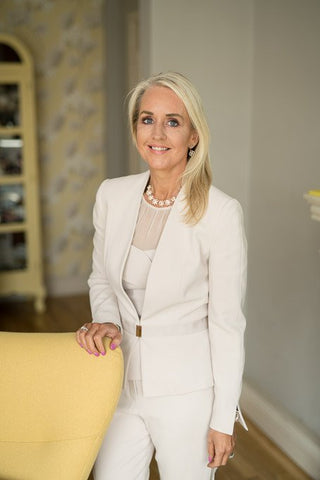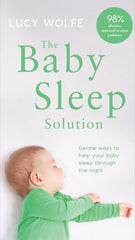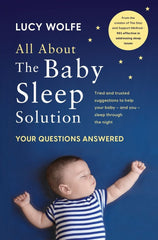Helping children become great sleepers is one of the toughest challenges parents face. It’s no wonder countless sleep-focused programs, strategies, and philosophies are shared every single day. But when you really need help, it’s difficult to know where you should turn! Today we’re hoping to cut through some of that noise by sharing research-based expertise from a trusted source.
Tired parents, meet LUCY WOLFE, Ireland’s leading sleep expert. Lucy is a Pediatric Sleep Consultant, Co Creational Parent and Relational Mentor, best-selling author, and mom to four children. And In addition to today’s post, Lucy and I will be hosting an Instagram LIVE on Wednesday, April 27 at 10 a.m. PST on @lucywolfesleep! I hope you’ll join us there to learn more and ask your burning questions about improving sleep habits for your children!

You may have read Lucy’s wildly popular books, THE BABY SLEEP SOLUTION and ALL ABOUT THE BABY SLEEP SOLUTION, which lay out her gentle stay-and-support method while addressing common sleep disruptions. With a focus on long-term, lasting results, Lucy’s approach is one that honors the science of sleep and the child’s biological rhythms and emotional needs. Lucy recently formulated a 100% all natural SLEEP THROUGH line of products—including a Sleep Spray and Relaxing Rub—to complement her approach, and we’re oh-so-here for it. I hope you enjoy our quick chat, and please pop into the comments to join the conversation!
Nina Westbrook — You are a sleep consultant, co-creational parent and relationship mentor, and mum of four children. Can you tell me more about your co-creational approach and how your own experience as a mother inspired you to pursue the study of child sleep development?
Lucy Wolfe — Ultimately, I decided to pursue training and education in this area when I couldn’t access relevant support for my own sleepless child nearly 20 years ago. After realizing that emotionally healthy and considerate parent support was absent for many, I decided to become the person that I wish I had been able to see at that vulnerable time. This meant re-entering education and re-training. And this journey continues. My approach is holistic and co-creational, in that I address every aspect of the child’s story and family culture, make positive sleep adjustments from a feeding and sleeping perspective, and use my stay and support approach to help transition to better sleep, all at a rate and pace that feels right for both the child and the parent based on the informed decisions that we are making together.
NW — What is one crucial habit new parents should develop for their baby in the first few weeks to establish and/or maintain healthy sleep patterns?
LW — For me, it is that your child feels seen, heard, loved, and belonging to the family—focusing on loving and responsive attunement and nurturing the loving-trust bond—meeting the baby’s needs with love and care and meeting them in the space of their own individuality. Lots of eye contact, quality presence, and dialogue between parent and child. And then within this context, learning to read the language of sleep: brief eye rubs, brief yawns, and discreet moments of quietness—rather than waiting for overtired cues represented by intense, obvious symptoms that may make achieving and maintaining sleep more challenging for both the baby and the parent.
NW — You also mention that sleep issues are not only common in babies; they’re common for older children as well. What are some reasons older children might encounter sleep issues, and what are 2 – 3 things parents can do if their older child begins to wake up throughout the night?
LW — Yes, studies show that sleep issues linger well beyond the time that parents reasonably anticipate sleepless nights. The reasons for this are multi-dimensional, bearing in mind that everything that the child thinks, feels, sees, does, eats, and drinks contributes to their sleep tendency and so too the parents’ emotional mindset and responses. Many long-standing issues are influenced by inadequate day time sleep, overtiredness at bedtime, low sleep ability, and unpredictable or re-enforcing responses overnight. When addressing childhood sleep, honor the environment, define where you want your child to sleep, and observe age-appropriate feeding and sleeping balances—together with calm and connected bedtime routines and my stay and support approach to promote sleep ability. This often means parents begin a stage-based sleep learning program designed to help them gently and considerately promote their child’s relationship with sleep.
NW — There are lots of products that offer support for a better night’s sleep, and you actually have a few of your own as well! What would you say is the one product you always recommend to a family interested in improving their child’s sleep?
LW — I propose anything that helps to create rituals at bedtime, underpinning touch and smell—like a massage oil, lotion, or pillow spray. Regularity with sleep and the steps that we take close to sleep time and the scents that we use can all help to send the right messages to the brain. More than anything, children love one-on-one time with their parent, and I always endorse that as part of the bedtime routine, continually underpinning the loving belonging to the family.
NW — What are 2 – 3 habits or activities parents can adopt in the morning and in the evening that will help their child sleep through the night?
LW — Have a regular wake time, somewhere between 6:00 am and no later than 7:30 am. Always get up and press start on the day. Expose to bright and, when possible, natural light, and always start the day with a feed. Provide naps as needed as per your child’s age range and honor what I describe as being the nap gap dynamic. This is the amount of awake time between the last nap and bedtime (4-8m: 2-3 hours; 8-18m: 3-4 hours; and 18m-3 years: 4-5 hours). If you can complement the regular wake time with a regular bedtime too within this timing, then it is a good foundation for parents to nourish and nurture their child’s sleep tendency.
NW — You shared a post about barriers to sleep success. Could you tell us more about these barriers and how they play a role on a child’s sleep patterns?
LW — In my practice, my work is evidence-based and practice informed, which means that many of my suggestions are founded on what I see being relevant in the work I do individually. Time and again, I see influences that create a barrier to the sleep goals parents set out. For example, a milk feed too close to sleep time may prevent your child being able to cycle through their overnight sleep phases; a too-long awake time before bedtime may encourage frequent night waking; a nap imbalance may mean that bedtime is resisted. I try my best to inform and demonstrate what small adjustments may help move parents closer to their sleep goals, acknowledging individuality and embracing variability too.
NW — I love that your Instagram account is so full of educational resources and support! You share tons of tips, but one of our favorites focuses on sending the right message for bedtime. Can you briefly outline what a proper bedtime routine looks like?
LW — Thank you, I love sharing my craft—so many families struggle, and I know that often small changes make a difference. My proposed bedtime rituals are focused on offering a preparation for sleep before overtiredness occurs. The bedtime routine is ideally offered in the bedroom that your child will sleep in, in a dimly lit environment that supports sleep hormones. There should be about 20 minutes for getting changed, with lots of opportunity for connection and engagement between parent and child, such as storytelling, cuddles and songs. I find that the more connection there is during a well-timed bedtime, the less resistance will be established overall.
NW — You wrote a best-selling book called The Baby Sleep Solution and another highly acclaimed book titled All About the Baby Sleep Solution. Which do you suggest parents read first, and what can parents expect to learn from these resources?
LW — I always propose starting with The Baby Sleep Solution, as it covers sleep from birth and encapsulates my sleep shaping concepts from birth together with the gentle sleep learning thereafter. The second book is just as valuable and was designed with parents’ questions in mind. I was aware of how challenging it can be to read a whole book, and that often rapid answers are helpful, so All About the Baby Sleep Solution is designed this way. The book answers the many questions that arise from birth to about 3 years of age. Both are fabulous resources for parents on a quest for better, more, and nourishing sleep for their baby and family.
It was such a joy hearing from Lucy and I know this must have generated some questions! If so, drop them below and join us @lucywolfesleep for an Instagram LIVE discussion on Wednesday, April 27 at 10 a.m. PST!


